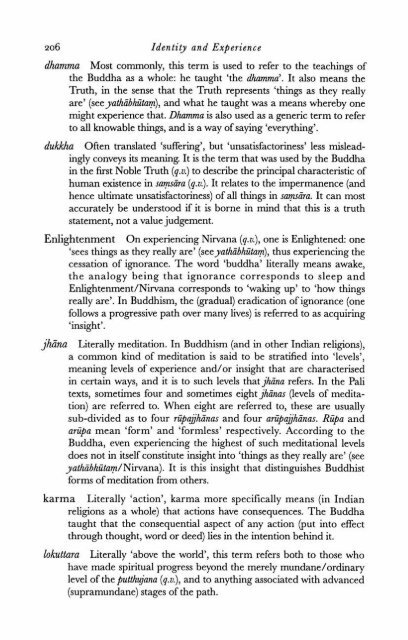Identity and Experience_Hamilton_1996
Identity and Experience_Hamilton_1996
Identity and Experience_Hamilton_1996
Create successful ePaper yourself
Turn your PDF publications into a flip-book with our unique Google optimized e-Paper software.
206 <strong>Identity</strong> <strong>and</strong> <strong>Experience</strong><br />
dhamma Most commonly, this term is used to refer to the teachings of<br />
the Buddha as a whole: he taught 'the dhamma'. It also means the<br />
Truth, in the sense that the Truth represents 'things as they really<br />
are' (see yathibhzitam), <strong>and</strong> what he taught was a means whereby one<br />
might experience that. Dhamma is also used as a generic term to refer<br />
to all knowable things, <strong>and</strong> is a way of saying 'everything'.<br />
duma Often translated 'suffering', but 'unsatisfactoriness' less misleadingly<br />
conveys its meaning. It is the term that was used by the Buddha<br />
in the first Noble Truth (9.v.) to describe the principal characteristic of<br />
human existence in saysara (q-v.). It relates to the impermanence (<strong>and</strong><br />
hence ultimate unsatisfactoriness) of all things in sarpira. It can most<br />
accurately be understood if it is borne in mind that this is a truth<br />
statement, not a value judgement.<br />
Enlightenment On experiencing Nirvana (q.~.), one is Enlightened: one<br />
'sees things as they really are' (see yathabhzitam), thus experiencing the<br />
cessation of ignorance. The word 'buddha' literally means awake,<br />
the analogy being that ignorance corresponds to sleep <strong>and</strong><br />
Enlightenment/Nirvana corresponds to 'waking up' to 'how things<br />
really are'. In Buddhism, the (gradual) eradication of ignorance (one<br />
follows a progressive path over many lives) is referred to as acquiring<br />
'insight'.<br />
jkna Literally meditation. In Buddhism (<strong>and</strong> in other Indian religions),<br />
a common kind of meditation is said to be stratified into 'levels',<br />
meaning levels of experience <strong>and</strong>/or insight that are characterised<br />
in certain ways, <strong>and</strong> it is to such levels that jhiina refers. In the Pali<br />
texts, sometimes four <strong>and</strong> sometimes eight jhanas (levels of meditation)<br />
are referred to. When eight are referred to, these are usually<br />
sub-divided as to four riipajhinas <strong>and</strong> four arzipajhinas. Rzipa <strong>and</strong><br />
ariipa mean 'form' <strong>and</strong> 'formless' respectively. According to the<br />
Buddha, even experiencing the highest of such meditational levels<br />
does not in itself constitute insight into 'things as they really are' (see<br />
yathibhzitam/Nirvana). It is this insight that distinguishes Buddhist<br />
forms of meditation from others.<br />
karma Literally 'action', karma more specifically means (in Indian<br />
religions as a whole) that actions have consequences. The Buddha<br />
taught that the consequential aspect of any action (put into effect<br />
through thought, word or deed) lies in the intention behind it.<br />
lokuttara Literally 'above the world', this term refers both to those who<br />
have made spiritual progress beyond the merely mundane/ordinary<br />
level of the putthujnna (g.v.), <strong>and</strong> to anything associated with advanced<br />
(supramundane) stages of the path.


